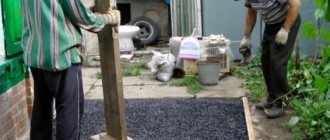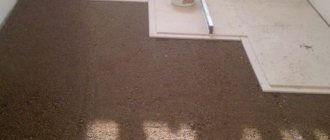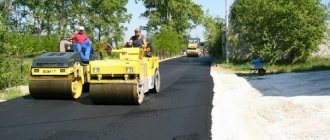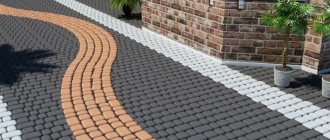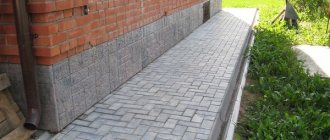Is it possible to lay paving slabs on asphalt? — Metals, equipment, instructions
The question of whether it is possible to lay paving slabs on asphalt arises quite often before arranging a local area: on the one hand, you don’t want to remove the still durable old coating, on the other hand, it clearly requires repair or replacement.
Paving slabs are chosen for a new coating for several reasons: durability, strength, aesthetics, wide choice of textures/shades/sizes, frost resistance, wear resistance. The tile consists of natural components, is absolutely environmentally friendly and safe, heats up less in the sun compared to asphalt, does not emit toxic substances at high temperatures, and does not crack or collapse at low temperatures. Therefore, the choice of material is quite understandable, but whether it is advisable to completely remove the old asphalt or leave it as the bottom layer of the new coating can be quite difficult to decide.
Is it worth laying tiles on asphalt: pros and cons
According to all construction rules and regulations, paving slabs are not placed on asphalt. If you do everything according to the standards, then you first need to remove the old asphalt, thoroughly clean and prepare the surface, and only then lay a layer of tiles. But it is not always possible and willing to spend a lot of effort and time dismantling old asphalt, so in some cases tiles are laid on it.
It is important to remember several nuances here.
The main problem is that laying paving slabs on asphalt can make the tile layer short-lived - in the future it can sag and become deformed. This is due to the fact that a cracked and deformed asphalt layer can interact unevenly with moisture, which tends to accumulate and swell the soil at the base. Through the cracks of the tiles, water can enter the asphalt, accumulate in the layer between the coatings and then provoke various deformations.
But this trouble can be avoided, especially if the tiles can withstand light daily loads. In individual construction, in areas where dozens of people do not walk every day, it is quite possible to lay paving slabs on asphalt. There are several ways to complete the task.
Why are there doubts?
It is worth considering other reasons for the reluctance of many professionals to lay tiles over old asphalt pavement. The first and main reason is moisture - if paving stones, laid correctly on a prepared surface, are not afraid of the effects of water and precipitation, then old asphalt can accumulate water or prevent it from freely going into the ground.
Water accumulates in the space underneath the slabs, swells the soil, freezes in winter, undermines the paving stones, completely deforms the paving slabs after wintering, and requires repairs. Such cases occur when they decide to lay tiles on a continuous layer of asphalt.
The tiles are undermined and, if the old asphalt is not treated properly, it comes off in pieces and increases the mobility of the new layer. Potholes and cracks can be overgrown with moss and grass, and covered with debris.
If there is a need to leave the path on the site at the same level, then the question of whether it is possible to lay paving slabs on the asphalt does not arise at all. After all, if you do not remove the old asphalt, the level of the path will rise, you will have to raise all storm drains, curbs, gates, gates, etc. may stop opening.
When deciding whether to lay paving slabs on an asphalt surface, all these nuances are taken into account. Tiles are laid on solid asphalt only after drilling a large number of holes for high-quality drainage - they are made with a hammer drill with a long drill with a diameter of 15-20 millimeters, drilling down to the bedding in a grid format with a cell size of 10-20 centimeters.
Two ways to lay paving slabs on asphalt
First of all, it is necessary to highlight two methods of laying paving slabs on asphalt, each of which allows you to obtain an even, reliable coating.
1) The first one is carried out like this: install all the elements of the coating, compact the tiles with a hammer (rubber or wooden), keeping an eye on the level so that not a single tile sticks out or falls through.
2) Second - first, all elements are installed without compaction, then a sheet of rubber is placed under the vibrating rammer, and they begin to fix each tile. The surface is perfectly flat.
Laying tiles
Before laying paving slabs on asphalt, you need to prepare the necessary tools and materials: washed river sand, sufficient water, cement (dry), rakes, building rules, boards (long and even, preferably), metal profiles (or standard beacons). To avoid unnecessary financial costs, you need to correctly perform the installation technology, without skipping a single stage of work.
Preparing the base
First prepare the surface for laying. If the asphalt is smooth and durable, it is enough to fill in a cushion of sand 10 centimeters thick and level it, compact it with a vibrating plate with constant irrigation. The installation of the curb at the marked level must be done immediately, concreted before pouring sand and laying the tiles.
The site is carefully and carefully leveled according to the rule, and then covered on top with a mixture of cement and sand with a layer of 5 centimeters. Sand and cement are mixed in a ratio of 3 to 1. It is advisable to fill the top layer and level it along the beacons - this way it will be possible to achieve an even base and tile covering.
The line is pulled according to the established level, the steel profiles are installed in carefully compacted sand, then the spaces between the profiles are evenly filled with a mixture of cement and sand, the layer is compacted, the rule is leveled according to the beacons, the profiles are removed, and the voids are carefully filled in.
Concreting
If the old asphalt surface is unusable and uneven, you cannot do without a concrete screed. Thanks to the screed, you will be able to obtain a smooth and durable base for laying a fresh layer of tiles. At this stage, you need to take care of drainage so that moisture does not collect under the tiles.
Drainage is created before pouring concrete: first, short pieces of asbestos pipe are prepared (suitable with a diameter of 63 millimeters), then they are drilled through the asphalt using a hammer drill with a thick drill at the rate of one hole per square meter, and the pipes are inserted. It is worth mentioning here that when pulling the fishing line to set the concrete pouring level, be sure to provide a slope of at least 5 degrees.
Next, a lining is installed, a reinforcing mesh on top, formwork, beacons, and a 10-centimeter thick screed is poured over them. The pipes should protrude slightly from the surface of the concrete; after hardening, the excess is cut off or beaten to the level of the screed, and the formwork boards are removed.
Then a cushion of sand is poured, a mixture of cement and sand is placed on top, and tiles are laid. The bottom layer of sand must spill into the drainage holes. This will ensure that moisture escapes into the soil at the base and the paving slabs will last as long as possible even with sudden changes in temperature and moisture.
Laying process
Before laying paving slabs on the asphalt, stretch a fishing line along the longest opposite sides of the site (or along the sides of the path). Then they take a fishing line slightly longer than the total width of the area and attach pegs at the ends. This segment is installed across the entire area along level (beacon) lines and during the laying process is moved to each new row.
There is an alternative to asphalt!
Inventors are constantly looking for ways to replace asphalt, and the material must be environmentally friendly and safe. Today, the eyes of scientists are turned to plastic, which has practically filled the entire planet. Mountains of plastic containers pile up in landfills, polluting the environment. Although used plastic is being recycled, the capacity is still extremely low.
The Dutch from VolkerWessels were the first to get down to business. They propose using plastic instead of the usual asphalt for road surfaces. The fact is that:
- Plastic lasts longer.
- You won’t have to maintain such roads: savings!
- Indifferent to temperature extremes.
- The cost of the material will be significantly lower.
- Installation is done quickly.
What to choose: paving slabs or asphalt
Submit your request
Call back Send request
The most popular coatings for sidewalks, parks and alleys are paving slabs and asphalt.
In the article you will find comparative characteristics of both coatings, learn their strengths and weaknesses, price and installation technology.
Why is the sidewalk covered?
Drawing on a paving stone sidewalk
To find out which is better, paving slabs or asphalt, you need to understand what the sidewalk coating is for and what qualities it has.
What is a sidewalk? This is a path that is comfortable to walk on and separates the pedestrian from the mud when it rains. The sidewalk curb separates pedestrians from lawns and the roadway, protecting them from cars.
Rain turns the ground around into mud and swamp, but the pavement remains hard. The ground around is uneven, with potholes, bumps, and elevation changes, but the sidewalk is smooth and level.
It’s hard to walk through mud, shoes slip, but on the sidewalk the grip of shoes and the surface is enough for comfortable and safe movement. In addition, the sidewalk is part of the landscape design of the area.
The following is expected from pavement covering:
- high resistance to wear so that it does not have to be replaced every year;
- sufficiently rigid so that it does not fall under your feet;
- good grip on shoes, which will ensure safe movement even during rainfall;
- sufficient frost and water resistance so that rains and frosts do not destroy it in 2-3 years;
- consistency with the interior of the site.
The technology for preparing the base for paving slabs (with the exception of ceramic, clinker, porcelain stoneware and polymer concrete) and asphalt is identical.
You can get acquainted with the technology for preparing the base in the article (preparing the base).
Paving slabs
In terms of wear resistance, paving slabs (vibration-pressed, with a certificate of conformity, laid on a high-quality base) are several times superior to asphalt. The service life of tiles (subject to installation technology and loads that correspond to the design ones) is from 50 to 80 years. Due to the variety of shapes and colors, tiles are laid in different patterns. The cost of laying one square meter is from 3 thousand rubles, which is more than twice as expensive as the cost of laying the same amount of asphalt.
Laying paving slabs
The difference in price arises due to manual labor, which requires highly qualified workers. The tiles must not just be laid on the sand, but each one must be laid separately, checking the height and slope.
If individual elements of paving slabs are damaged, they must be replaced with similar ones. If during installation you did not leave a reserve for repairs, you will have to completely change the coating. If you hired a specialist to repair or lay tiles (on a ready-made base), then the cost of the work will be 100-150 percent of the cost of the tiles.
To find out how different types of paving slabs differ, read the article (How to choose the right paving slabs). If you want to learn how to lay paving slabs, read the article (how to lay figured tiles).
Asphalt
In terms of wear resistance, even high quality (in compliance with the requirements of GOST and SNiP) laid asphalt is 2-3 times inferior to paving slabs. The service life of asphalt pavement is 20-30 years. The strength of the coating is affected by bright sun and temperatures above 40 degrees in the shade, temperature changes from plus 5 to minus 5 and above, and heavy rainfall.
There are technologies for increasing the wear resistance of asphalt pavements, for example, pouring a protective layer. The cost of such work is 10-20 rubles per square meter.
The price of laying asphalt pavement (including the construction of the base) is 1-1.5 thousand rubles per square meter. The cost of replacing the coating on an existing base is 400-600 rubles per square meter. In case of damage to individual areas, the asphalt pavement is easy to repair; the price of repair depends on the technology and materials and does not exceed 300 rubles per square meter.
Asphalt sidewalk
Tile or asphalt
Each coating has its own pros and cons. Tile is more difficult and more expensive to install, but tiled roads and sidewalks look more beautiful and last longer. The tiles are not afraid of heat and are less sensitive to temperature changes. Laying asphalt is 2-3 times cheaper, and replacing the surface without repairing the underlying layers (base) is 5-10 times cheaper.
If the supply of tiles has been lost during the operation of the sidewalk, then in order to maintain its attractiveness, you will need to either look for identical tiles (which is quite difficult) or completely change the coating. If a section of asphalt pavement is damaged, it is enough to carry out inexpensive pothole repairs and fill the sidewalk with a protective layer.
If you purchase low-quality tiles, including those made using cast technology, you will lose half the benefits of the blind area. The strength, wear and frost resistance of cast tiles is 10 times lower, and vibrocast tiles are 2-3 times lower than vibropressed tiles.
If mistakes were made when preparing the base or laying the tiles, such a coating will be inferior in strength to well-laid asphalt.
If you need a beautiful decorative coating with high reliability, frost and wear resistance, you are not embarrassed by the price of 3 thousand rubles per square meter and the need to completely replace the coating in case of minor damage, choose tiles.
If you need an inexpensive coating that is easy to repair if necessary, choose asphalt. Now you know the advantages and disadvantages of these coatings and know how to choose them according to load, price and other parameters.
[contact-form-7 404 “Not Found”]
Source: https://trotuar.biz/trotuarnaya-plitka-ili-asfalt/
Production of cold asphalt
In accordance with the requirements of the Federal Law of July 27, 2006 No. 152-FZ “On Personal Data,” I express my consent to the processing by LLC “ROKFLEX” INN 6670481050, OGRN 1196658024342, of my personal data without reservations and restrictions, to perform actions with my personal data , provided for in clause 3, part 1, article 3 of the Federal Law of July 27, 2006 No. 152-FZ “On Personal Data”, and I confirm that, by giving such consent, I am acting freely, of my own free will and in my own interests. Consent to the processing of personal data is given by me in order to receive services provided by ROKFLEX LLC.
List of personal data for the processing of which consent is provided: last name, first name, patronymic, telephone numbers, email addresses (E-mail), as well as other personal data received from me.
I express my consent to carry out the following actions with all specified personal data: collection, systematization, accumulation, storage, clarification (updating or changing), use, distribution (including transfer), depersonalization, blocking, destruction, transfer, including including cross-border transfer, as well as carrying out any other actions with personal data in accordance with current legislation. Data processing can be carried out both with the use of automation tools and without their use (with non-automatic processing). When processing personal data, ROKFLEX LLC is not limited in the use of methods for processing it.
I hereby acknowledge and confirm that, if necessary, ROKFLEX LLC has the right to provide my personal data to third parties solely for the purpose of providing technical support services, as well as (in anonymized form) for statistical, marketing and other scientific purposes. Such third parties have the right to process personal data on the basis of this consent. This consent is valid until the date of its withdrawal by me by sending to LLC "ROKFLEX" a corresponding written statement signed by me, which can be sent by me to LLC "ROKFLEX" by registered mail with return receipt requested, or delivered personally against signature to a duly authorized representative of LLC "ROKFLEX". If I receive my written application to withdraw this consent to the processing of personal data, ROKFLEX LLC is obliged to stop processing it and exclude personal data from the database, including the electronic one, with the exception of information about the last name, first name, and patronymic.
I understand that putting an o in the field to the left of the phrase “I accept the terms of the “Agreement for the processing of personal data” on the website www.rockflex.ru below the text of this Agreement means my written consent to the terms described in it.
Which is better: paving slabs or asphalt
› Articles › Paving slabs › Which is better: paving slabs or asphalt
The final stage of construction of a private house is the improvement of the surrounding area. Every owner thinks about the question of how to pave the paths and areas on his site. There are several options for solving this problem, the most common of which are paving with asphalt or paving slabs.
Disadvantages of asphalt
- Harmful fumes into the environment.
Asphalt contains up to 60% bitumen, which is a by-product of oil refining. When it is heated above 25 ° C, carcinogenic substances begin to be released, which harm the environment and human health. This suggests that in summer in warm weather it is simply dangerous to be near an asphalt area. - Fragility.
The service life of asphalt is significantly inferior to other types of coating, in particular paving slabs. It is 7-10 years. Over time, under the influence of bright sun, temperature changes, and precipitation, the asphalt cracks and sags, creating inconvenience on the site and spoiling its appearance. - Asphalt retains water.
Asphalt does not allow water to pass through, causing it to accumulate on its surface, forming puddles in your yard after precipitation. - Appearance.
Lacks variety. It can only be one color, which does not allow you to turn your design ideas into reality. - Unsuitable for repair.
If damage occurs on the asphalt surface, it is possible to replace only this area, but a visible mark will remain at the repair site. If it is necessary to carry out excavation work, the asphalt will have to be completely rebuilt.
Advantages of asphalt
- Low cost.
The cost of the material itself and laying asphalt is 2-3 times cheaper than paving slabs. - Smooth surface.
Unlike paving slabs, when laying asphalt, no seams are formed, the surface is even and smooth. - Asphalt can withstand heavy loads.
Asphalt, laid in one layer, can withstand the loads of pedestrian traffic, light vehicles, as well as small trucks and minibuses. Two layers of asphalt will withstand the load from the movement of large vehicles.
Advantages of paving slabs
- Environmentally friendly.
Unlike asphalt, paving slabs do not emit any harmful substances into the environment, since they are made from environmentally friendly materials. Also, paving stones do not disrupt gas and water exchange in the soil, which has a beneficial effect on its condition. - Durability, frost resistance.
Paving slabs are resistant to ultraviolet radiation and temperature changes, they do not crack, do not collapse and retain their original appearance throughout their entire service life (40-50 years). - Water does not accumulate on paving slabs.
The presence of seams helps the tile surface dry quickly and prevents the formation of puddles in the yard. - Ease of repair.
Paving slabs are easily dismantled and suitable for reuse. At the same time, the appearance of the place where it was replaced is not disturbed. - Appearance.
A variety of shapes and colors allows you to give individuality to each yard.
Paving slabs - an alternative to asphalt
It would seem that just recently we walked along asphalt sidewalks and thought that it could not be better. Especially listening to the memories of the older generation, who still remember the boardwalks. But over the past 10-12 years, we have seen that instead of fragile asphalt (which, as the hot days of this year have shown, turns into a liquid mess at air temperatures above 36 degrees), paving slabs are much more effective. Nowadays, it is no longer possible to imagine the appearance of a modern city (or any other populated area) without beautiful sidewalks and squares on which multi-colored paving slabs are laid. Although the tiles are called paving slabs, they can be used not only on sidewalks, but also for personal purposes in the country house, the pre-cottage area: such tiles are used to lay paved garden paths on a personal plot, to cover the area around a country house, to build a driveway to a house, etc. .
Using sufficient manufacturability of paving slabs, a variety of shapes and colors, they can be used to arrange original sidewalks, platforms and paths of any size and configuration.
Thus, the advantages of paving slabs compared to continuous asphalt pavement are obvious:
— the asphalt one or two years after laying is uneven, covered with cracks through which various vegetation breaks through. Paving slabs do not lose their shape or color for a long time, and weeds do not grow through them. This is especially important for a personal plot.
— if it is necessary to lay or repair underground communications or redevelop the territory, the asphalt will have to be broken and then laid new. And paving slabs can be removed quite carefully without breaking and can be re-laid after completion of underground work. Moreover, the number of such manipulations is unlimited, the main thing is not to cause mechanical damage to the tile when dismantling it;
- in extreme heat, asphalt tends to “melt”, release harmful fumes, soften, make it completely impossible to walk on it, and damage shoes. The heating of paving slabs is significantly less, it retains its strength and does not emit harmful substances under any weather conditions;
— after heavy rain, puddles form in uneven asphalt. There is no such thing on paving slabs, since water can drain and be absorbed into the ground through the gaps between the tiles, while they themselves remain without water;
— paving slabs have greater frost resistance and wear resistance, so their durability cannot be compared with asphalt (service life is at least 30 years).
To lay asphalt, special technology and asphalt-laying machinery and equipment are used, it requires a lot of labor, this work is hard, dirty, and breathing the fumes of hot asphalt is very difficult and harmful.
Laying paving slabs does not require any special equipment; the technology for laying it is very simple. Two methods are used for the production of paving slabs - vibrocompression
or
vibration casting
. In the first method, solid mixtures of cement, various fillers, additives are used, with a minimum water content. And in the second method, mixtures with water, fillers, and additives are used, which are poured into appropriate forms. In both methods, the end result is wonderful paving slabs. Thanks to their advantages, purchasing paving slabs is not very difficult. Paving slabs are sold wholesale even in specialized online stores. To do this, you just need to make the necessary search query.
Return to list
What is cheaper: asphalt or paving slabs
Submit your request
Call back Send request
The most popular coatings for sidewalks, parks and alleys are paving slabs and asphalt.
In the article you will find comparative characteristics of both coatings, learn their strengths and weaknesses, price and installation technology.
What is better in the yard of a house: concrete or asphalt?
Any owner of a country property must choose what materials to use to equip the approach to the house, the entrance to the site, as well as parking for his “steel horse”.
That is, what is better to choose for these purposes: concrete or asphalt? Or maybe stop at paving slabs? Which is easier to arrange yourself? In what case will it be necessary to resort to the help of a special team of workers? Which materials are more practical, that is, wear-resistant? How much will it cost to purchase materials, install and operate them? Which is cheaper?
Based on the fact that the technology for laying asphalt and concrete is approximately the same, the most important thing is to understand the main advantages and disadvantages of each method and decide for yourself what suits you better both in terms of cost and technical characteristics of a particular coating .
On a note! Don't skimp on coverage. Remember: “the miser pays twice.”
Criteria for evaluating the material you are going to use
The main criteria for assessing the choice of coating material are the following:
- the ability to quickly deliver materials to their destination;
- their cost (including delivery, unloading, installation of the coating and its ongoing repair);
- service life;
- labor costs to maintain the coating in good condition.
The fundamental difference between asphalt and concrete
Asphalt (artificial or natural) contains bitumen (waste from the oil industry) in combination with gravel (or crushed stone) and sand (it is the filler). Moreover, in the first version the amount of bitumen is 13-60%, and in the second it is about 60-75%.
On a note! Mineral powder is added to artificial asphalt.
Concrete consists of cement, sand, crushed stone of large fractions (this is the filler), water and artificial components. Depending on the binders, additives and fillers, coatings with different characteristics are obtained.
Advantages and disadvantages of asphalt pavement
The undoubted advantages of arranging an asphalt surface include:
- The costs of purchasing all the necessary materials are relatively low (for example, compared to concrete and paving slabs).
- The lead time for asphalt laying work is not too long.
- Asphalt is durable (does not sag or deform), so it is perfect for arranging garden paths or car parking spaces.
- The coating material is practically not subject to corrosion.
- High-quality asphalt does not have any cracks or gaps: therefore, grass does not grow through it.
Source: https://betfundament.com/chto-deshevle-asfalt-ili-trotuarnaya-plitka/
Technology of laying tiles on asphalt pavement
Required tools and materials:
- sand (preferably washed river sand);
- dry cement;
- water;
- rule;
- rake.
To make it easier to maintain the same thickness throughout the entire area, you can use tube guides. Use a rake to evenly distribute the mixture over the marked area.
Before laying tiles on asphalt, you need to prepare the area. First of all, you need to pour a layer of sand about 5-10 cm thick. With this you can level out all kinds of potholes, protrusions and other irregularities on the old surface. Next, the sand must be carefully leveled using a rake and a rule, and it can be compacted by pouring water from a watering can. After this, it will not be superfluous to pour a layer of a special mixture of cement and sand, which is sold ready-made in a hardware store. However, it will be cheaper to prepare such a mixture yourself. To do this, you need to take sand and cement at a ratio of 3:1 and mix thoroughly. The layer should be laid no more than 5 cm thick, after which it can also be sprinkled with water. Once the mixture sets, it will better hold the paving slabs and prevent them from moving.
Asphalt or paving slabs, choose a coating
Those who have their own country house or just a summer cottage are very lucky. After all, there is nothing better than going out of town with family or friends for a weekend barbecue or just getting some fresh air. But to make these trips a real pleasure, the owners of such houses try to decorate the surrounding area as beautifully as possible. Therefore, they often have a question: what is better to pave pedestrian paths and the driveway to the house, asphalt or paving slabs? How can you improve your yard?
Options for arranging country paths
- We can assure you that there are not as many possible options as it seems. The first, it would seem, is the simplest - to sow lawn grass in the yard. Despite the fact that the option, at first glance, is the cheapest, has its drawbacks - when it rains, your yard will turn into a huge lake of mud. And if you walk on the grass or drive through it into the garage, then imagine what such a coating will turn into!
- The second option will seem more fun - cover the yard with asphalt.
But this is if you do everything according to the rules: first remove the soil, then fill everything with crushed stone, sand, compact it well, and only then lay asphalt. Having rolled it all out well, you will get a fairly even coating. But, unfortunately, with its drawbacks - imagine hot asphalt in extreme heat! It contains bitumen and resins, so most likely it will first begin to melt and then smell unpleasant.When it rains, you will find huge puddles on the surface of your asphalt surface. In addition, such a coating will not last long.
- The third option for improving your country house is to pave the yard with natural stone or paving slabs.
The necessary preparatory work is similar to the second method, although it has some minor features. And the cost of the material, if you decide to use paving slabs, will pleasantly surprise you (it does not differ much from the cost of asphalt). But not everyone can afford to pave the yard with natural stone.
Advantages of paving slabs over asphalt pavement
Let's take a closer look at how paving slabs (or paving stones, as they are often called) benefit from asphalt pavement. At the moment, the passion for “asphalt”, which took place quite recently, is gradually fading away. It is being confidently and persistently replaced by a new type of road surface - paving slabs.
Paving stones, now, solely due to their extraordinary qualities, have acquired the status of the most popular finishing material; they are widely used to pave areas adjacent to squares and parks, new supermarkets, various industrial facilities of the territory, as well as pedestrian areas in garden plots. After all, now it won’t be difficult to choose a tile that combines quality, price and durability.
- Paving stones are more economically beneficial than asphalt, since they can be laid manually without using special road equipment.
- Tile, unlike asphalt, does not retain water, but thanks to the gaps, it almost instantly allows moisture to pass from the surface into the ground.
- Recent scientific studies have proven that when the air temperature reaches over 30 degrees, asphalt begins to release benzene compounds that are harmful to the human body. While paving stones are made from environmentally friendly materials, and therefore even at high temperatures this road surface does not emit any chemicals. It does not interfere with the natural exchange of air and water in the soil, which has a beneficial effect on urban green spaces and has a positive effect on the ecological state of the environment.
- The incredible durability of the material (its service life is at least 25 years) has significantly increased the sales volume of paving slabs. This fact is also a huge advantage of paving stones over asphalt. This durability is due to the presence of drainage - the pavement coating easily allows water to pass through, while the surface remains undamaged. In those places where there is a possibility of rising groundwater, paving stones will become your savior (due to the presence of natural drainage, this coating allows water to pass through very well, while the surface remains undamaged).
- Paving slabs will become indispensable if you have to make repairs. Imagine how long it will take to remove asphalt pavement in the event of an underground communications failure. And you can easily disassemble the paving stones, and after troubleshooting, re-lay them in their original place (while saving on the purchase of new materials and on dismantling).
- And of course, if tiles did not have aesthetic advantages over asphalt, they would not have become so popular and sold. Due to the widest range of geometric sizes and a huge number of colors, using paving slabs you can create patterns for any whim. It will be much more aesthetically pleasing than gloomy gray asphalt.
To make the right choice between asphalt and paving slabs, you need to pay attention to the quality of the materials. The quality of paving slabs directly depends on what materials are used to make them and how professional the personnel who make them are.
Paving slabs are made from a sand-concrete mixture without adding any third-party fillers (such as crushed stone, coarse slag, etc.) This is a guarantee that the paving slabs will be resistant to frost and abrasion.
And adding fillers will significantly reduce its resistance to changes in environmental conditions.
https://www.youtube.com/watch?v=hE4N2znRVaY
Determining the quality of paving slabs is quite simple: it should have a smooth, even surface, a clear pattern, and there should be no chips or shells. Appearance - the tile must have a flat, smooth surface, with a clear pattern (if any) and must not have any shells or chips. On the side cut of high-quality tiles you will not see significant voids or other fillers.
Let's summarize
Based on the above, the difference between asphalt and paving slabs emerges: if you need an environmentally friendly, durable and beautiful coating, then the right decision would be to purchase high-quality paving slabs. But remember that when choosing paving slabs you should adhere to the principle - it is cheaper to buy a quality product once and use it for 15-25 years than to purchase consumer goods every year.
Source: https://www.budportal.com.ua/articles/vybiraem-pokrytie-asfalt-ili-trotuarnaya-plitka
Other advantages of paving slabs
If a path near the house is laid with paving slabs, then such work is carried out very quickly. And this approach has a number of significant and relevant advantages:
- the use of complex equipment is not required;
- all materials used in the process are accessible;
- the coating is durable.
When working with asphalt pavement, it is necessary to use, at a minimum, a mobile asphalt paver. The cost of renting such equipment exceeds the cost of purchasing most of the materials used in the process. If you buy high-quality paving slabs, for example, on the website https://protrotuarnujuplitku.ru/, then in addition you will only need to pay for the services of professional builders who lay them.
Another question is how to choose a manufacturer of such materials. Most likely, you will have to cooperate directly with such a company. After all, the cost of the products offered in the retail network is significantly higher than wholesale prices. But you need to choose suitable products not based on price, but still on quality. If you need both high-quality paving stones and a garden border, then it is better to consult with professionals who understand such issues much better than you.
The products of those companies that have been operating in a certain market for a long time are in demand among consumers. And you can get an approximate idea of which products are best used to equip a summer cottage or local area, and which ones should be avoided. And if real construction professionals work with you, then the likelihood of purchasing high-quality tiles increases even more.
Some users believe that the surfaces created in this way are not reliable and durable. They say that individual tiles can simply fly out. But if the installation of paving stones is carried out correctly, then nothing like this will happen in the near future. If a path is laid with paving slabs, then this process is reminiscent of a game of mosaic, when a full-fledged structure is created from many small parts.
Land development, which is more expensive: laying asphalt, concrete or paving slabs?
Back
- Asphalting
- Concreting
- Paving slabs.
Every owner of a private house has faced the issue of landscaping the courtyard area on their property. The owner usually chooses which is better between several traditional options: asphalt or paving slabs, concrete. In order to take a balanced approach to solving the issue, you should consider these arrangement methods from the point of view of practicality, wear resistance, installation cost and the cost of maintaining the coating in an attractive form.
Asphalting
Asphalting is a common way of arranging paths and areas in the yard of a private house. The work is carried out according to the standard scheme: first, the soil is leveled, then a layer of crushed stone or clay-sand mixture is poured, and asphalt is laid on top with a 4 cm layer. During the soil leveling process, the storm drain necks are raised to the required level and curbs are installed. For the yard, the bedding layer is 10-15 cm, since intensive loads (heavy vehicle traffic) are not expected.
Asphalted yard path
Asphalting is attractive because, of all other options for arranging sites and paths, the cost of materials is the lowest, and the completion time is short. Typically, a team of 4 people will spend 2 days to roll out a site of up to 500 square meters. You can walk on the asphalt surface immediately after rolling.
The material has more disadvantages than advantages:
- Compared to tiles or concrete, the service life of asphalt is short, no more than 10 years. Upon reaching this period, the coating will have to be changed, since by then the asphalt will be cracked and patched.
- Another significant drawback is associated with the presence of bitumen in its composition. When heated, bitumen components emit a specific odor, which can be a problem for sensitive people. When heated, the bitumen softens and the smooth surface becomes deformed from slight pressure.
- The maintainability of asphalt is practically zero. If cracks or potholes appear, you will have to install patches that spoil the appearance. Broken integrity still contributes to further destruction and the appearance of cracks on the surface. If it is necessary to repair communications under the asphalt path, it will have to be torn down. It will not be possible to restore the coating to its original appearance; asphalt will have to be laid over the entire area again.
Defects on the asphalt site
- The asphalt surface does not allow water to pass through, and after rain, puddles remain on it for a long time.
How much does it cost to lay paving slabs on asphalt?
The cost of all work on laying paving slabs on asphalt directly depends on the condition of the old coating, the new material chosen and the involvement of specialists. If the old asphalt is in good condition and you can do without a cement screed, this will reduce costs. The price of paving slabs can be anything - it all depends on personal preferences and requirements.
All work can be done independently or you can hire professionals - in this case you need to count on costs in the range of 300-800 rubles per square meter (but a lot depends on the characteristics of the territory, conditions, type and type of paving slabs, general cost estimate, etc.) . For example, square tiles are easier to install (and therefore work with them is cheaper) compared to figured ones.
Laying paving slabs on asphalt is a completely doable task that can be accomplished quickly and simply by doing everything yourself. In this case, it is imperative to take into account all the nuances, properly prepare the old coating and base, lay the layer of tiles carefully and evenly, and do not skimp on certain mandatory steps.
Asphalt or paving slabs? Advantages and disadvantages
» Asphalt or paving slabs? Advantages and disadvantages
If ten years ago asphalt was the unsurpassed leader in landscaping among organizations that improved the areas around their office buildings, and was in good demand among owners of private houses, today the situation has changed significantly. Paving slabs are becoming increasingly popular: many people buy them from various manufacturing companies, and some make them themselves. However, some continue to limit themselves to asphalt. What are the reasons for the growing popularity of tiles and the undying interest in the old version of the coating?
Characteristics of asphalt pavement
Laying asphalt on the surface of the same area will cost you significantly less than laying paving slabs. However, it is worth noting that over time, the asphalt will inevitably crack and “sag”, and weeds will begin to grow through it.
The disadvantages of asphalt also include the fact that in the heat it heats up and begins to emit a rather unpleasant odor, and after rain, dirt and puddles remain on it for a long time.
It is also inferior to paving slabs in mechanical strength and, of course, loses from an aesthetic point of view due to its nondescript and boring gray color.
Natural stone as an alternative to asphalt
Published: June 22, 2017
Increasingly, in small and large cities, you see paving stones or paving slabs on the roads instead of the usual asphalt, however, they are very expensive.
If asphalt is so cheap, why do they lay expensive paving stones or paving slabs instead?
- Firstly, paving slabs look very beautiful, they make the city bright and colorful, because this material has a wider range of colors than simple asphalt.
- Secondly, paving slabs or paving stones are more reliable and durable.
If paving slabs or paving stones are laid correctly, roads can last for many years. If the road is covered with asphalt, it will fail in a short time, because asphalt is exposed to various climatic and natural factors, and they, in turn, spoil it and make it unsuitable for further use. Well, thirdly, paving stones or paving slabs are considered a clean environmental product, so all granite materials will not affect your health in any way, but the same cannot be said about asphalt. After all, when heated, the asphalt surface begins to release harmful substances that dissolve with the air.
Today, paving stones and paving slabs are in very high demand among people. If we touch on the issue of the cost and efficiency of such roads, then we can say with confidence that roads that are lined with paving stones or tiles are much more durable than any other materials. After all, paving stones have a much longer and longer service life than other materials.
You will have time to change the asphalt road surface more than once during the period that the paving stones or paving slabs will serve you. Therefore, we can say with complete confidence that in a few years the costs of paving stones or paving slabs will pay off.
Our company employs only true professionals who deal exclusively with paving stones and paving slabs, and their professional activities have extensive experience.
On our website you will see all types of stones from various deposits, including paving slabs or paving stones of various types and in a variety of colors. Materials made of marble, granite, travertine, onyx - you can always buy from us only at low prices. Know that our experienced specialists will help you in your choice and will tell you the best and most optimal options. We always work only for you!
- Previous article Selecting material for cladding steps
- Next article Subtleties of choosing material for making a monument

